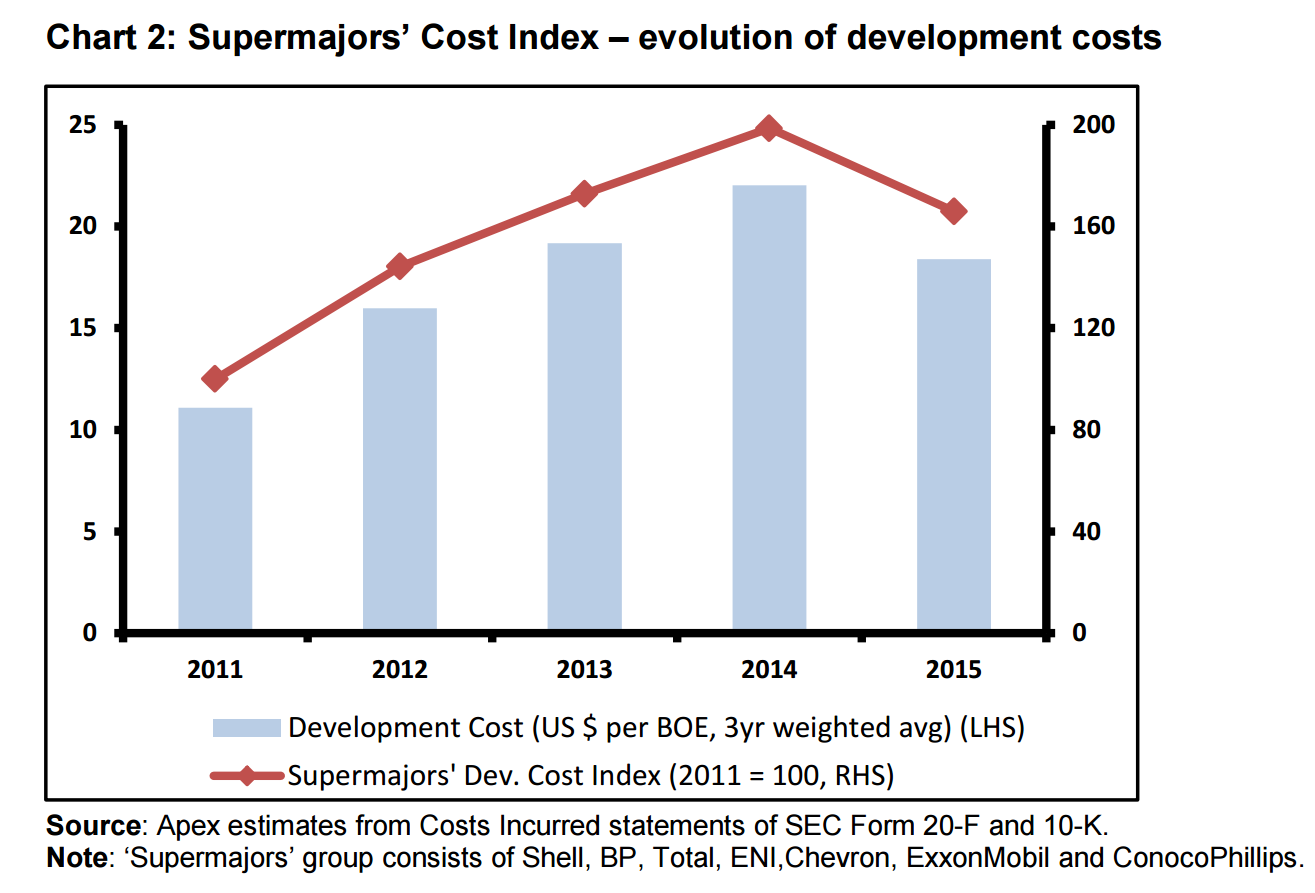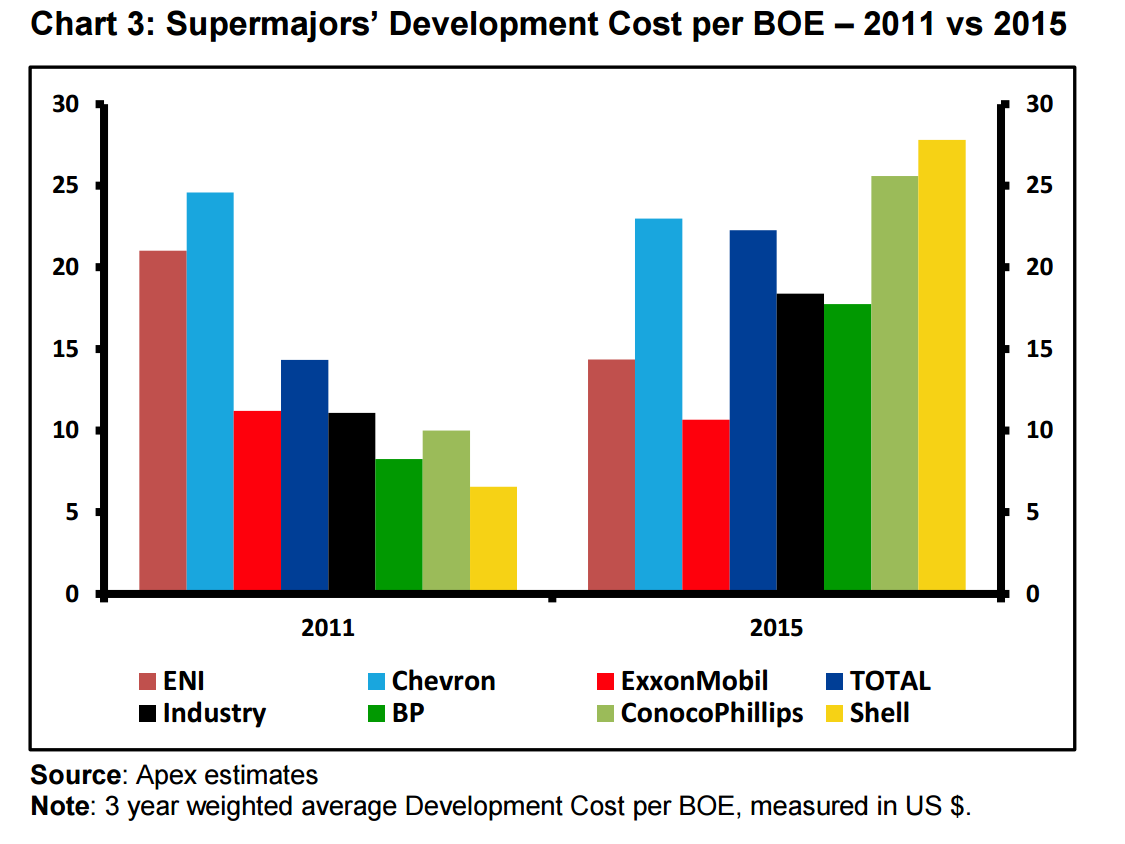www.aljazeerah.info
Opinion Editorials, March 2017
Archives
Mission & Name
Conflict Terminology
Editorials
Gaza Holocaust
Gulf War
Isdood
Islam
News
News Photos
Opinion Editorials
US Foreign Policy (Dr. El-Najjar's Articles)
www.aljazeerah.info
|
Oil Majors' Costs Have Risen 66% Since 2011 By Nick Cunningham Oil Price, Al-Jazeerah, CCUN, March , 2017 |
 |
 |
|
 |
The oil majors reported
poor earnings for the fourth quarter of last year, but many oil
executives struck an optimistic tone about the road ahead. Oil prices have
stabilized and the cost cutting measures implemented over the past three
years should allow companies to turn a profit even though crude trades for
about half of what it did back in 2014.
The collapse of oil prices
forced the majors to slash spending on exploration, cut employees, defer
projects, and look for efficiencies. That allowed them to successfully
lower their breakeven price for oil projects. However, some of that could
be temporary, with oilfield services companies now
demanding higher prices for equipment and drilling jobs, in some cases
upping prices by as much as 20 percent. The result could be an uptick in
the cost of producing oil for the first time in a few years. Rystad Energy
estimated the average shale project could see costs rise by $1.60 per
barrel, rising to $36.50.
That does not seem like the end of the
world. After all, those breakeven prices are still dramatically lower than
what they were back in 2014. In fact, Reuters put together a
series of charts depicting the fall in costs for shale production in
different parts of the United States. Every major shale basin – the Eagle
Ford, the Bakken, the Niobrara, and the Midland and Delaware basins in the
Permian – have seen breakeven prices fall by as much as half since 2013.
The slight uptick in costs expected in 2017 is a rounding error compared
to the reductions over the past half-decade.
But that is just for
shale drilling. The oil majors produce most of their oil outside of the
shale patch, with much of their output coming from longer-lived projects
in deepwater, for example. To be sure, some of the largest oil companies
have made some progress in cutting costs over the past few years, but a
new report casts doubt on the industry’s track record.
According
to new research from
Apex Consulting
Ltd., the oil majors are still spending more to develop a barrel of
oil equivalent than they were before the downturn in prices – in fact,
much more. Apex put together a proprietary index that measures cost
pressure for the “supermajors” – ExxonMobil, Royal Dutch Shell, Chevron,
Eni, Total and ConocoPhillips. Dubbed the “Supermajors’ Cost Index,” Apex
concludes that the supermajors spent 66 percent more on development costs
in 2015 than they did in 2011, despite the widely-touted “efficiency
gains” implemented during the worst of the market slump. It is important
to note that this measures “development costs,” and not exploration or
operational costs.
However, performances varied by company. Eni,
for example, saw its development costs decline by 32 percent between 2011
and 2015, a notable achievement. Chevron and ExxonMobil also posted
efficiency gains, although more modest figures than Eni. Chevron’s costs
fell 6 percent and Exxon’s were down 5 percent over the five-year period.
At the other end of the spectrum is Royal Dutch Shell, which saw
development costs quadruple. ConocoPhillips and BP fared only slightly
better, with costs roughly doubling over the timeframe. As a whole, the
development costs for the group of “supermajors” rose 66 percent to $18.39
per barrel.
After the collapse of oil prices in 2014, the cost
index did decline. Oil producers squeezed their suppliers, streamlined
operations, and improved drilling techniques. But costs still stood 66
percent higher than in 2011.
The index points to underlying
structural increases in development costs for the broader industry.
At $18 per barrel, the cost figure would seem rather low. But it is
important to note that this is just for “development costs,” which
represent just over half of a company’s total cost. That figure excludes
the cost of exploration as well as funding ongoing operations. So the
“breakeven price” so often quoted in the media is actually quite a bit
higher. BP, for example, recently
admitted that its finances will not breakeven unless oil trades at
roughly $60 per barrel.
The supermajors are in a tricky position.
They are trying to cut back on spending in order to fix their finances and
pay down the massive pile of debt that they have accumulated in the past
few years. However, their reserves will decline if they fail to replace
them. Exxon, for example, only replaced 67 percent of the oil it produced
in 2015.
Moreover, as Apex Consulting notes, oilfield services
might demand higher prices in the future as drilling activity picks up.
Right now, offshore rigs are still underutilized, meaning that price
inflation has yet to kick in.
In other words, the decline in costs
post-2014 are, at least in part, cyclical. Costs will rise again as
activity picks up unless oil producers work with their suppliers to
address the underlying structural costs of oil production.
Link to
original article:
http://oilprice.com/Energy/Energy-General/Oil-Majors-Costs-Have-Risen-66-Since-2011.html
***
Next Oil Rally? Futures Say Market Is Tightening
By Nick Cunningham
U.S. oil inventories are at record levels, but
there are a few glimmers of hope that the glut could be starting to subside.
Storing crude oil for sale at a later date is no longer profitable,
as the futures curve has flattened out in recent weeks, depriving traders of
a strategy that has served them well over the past few years. The market “contango,”
in which front-month oil contracts trade at a discount to oil futures six
months or a year out, has all but vanished. The differential must be large
enough to cover the cost of storage, and for many time spreads that is no
longer the case. After three years of a steep contango, storing oil simply
to take advantage of the time spreads is increasingly uneconomical.
One of the more expensive forms of storage is floating on tankers at sea,
and because of the narrowing contango, floating storage is unprofitable
today. Reuters reports that traders are beginning to unload crude from
floating storage along the Gulf Coast. "Right now, traders aren't
incentivized (to store)," Sandy Fielden, director of oil and products
research at Morningstar, told
Reuters in an interview. "It won't all stampede out of the gate, but
inventory levels will come down. What will happen is that some of it will go
to refineries, but a fair amount will be exported too."
Just as the
rapid rise of floating storage in 2015 and 2016 was a sign of the deepening
global supply imbalance, draining tankers of stored oil is an early sign
that the supply glut is receding.
So far, it is only the most
expensive storage facilities that are seeing drawdowns – the U.S. on the
whole has seen crude stocks swell to
record highs. But oil analysts argue that the surge in crude inventories
is a symptom of stepped up imports booked at the end of 2016, when OPEC
members pumped out huge volumes of crude just ahead of implementation of
their deal to cut production. After a few weeks of transit time, the extra
supply started showing up in U.S. storage data in January and February. In
other words, the stock builds could be a temporary anomaly.
More
recently, the time spreads for Brent futures also indicate increasing
tightness in the market. John Kemp of Reuters
notes
that the spread between futures between April and May has sharply narrowed
this month, meaning that the market is betting on a supply deficit as we
move into the second quarter. The spreads for May-June and June-July are
even smaller, trading at a few cents per barrel. This is a complicated way
of saying that there isn’t a way to make money by buying oil, paying for
storage, and selling it at a later date.
In a separate report,
Reuters notes that inventories are also starting to
drawdown in Asia, adding further evidence that the glut is not as bad as
feared. As OPEC has throttled back on production, Asia is starting to see
the impact. Reuters says that unusually large drawdowns took place across
key oil hubs in Asia – 6.8 million barrels of oil were withdrawn from tanker
storage off of Malaysia’s coast while Singapore saw a 4.1 million barrel
decline and Indonesia’s storage fell by 1.2 million barrels.
"Dancing contango is now not a profitable thing to do, so we've sold out,"
an oil trading manager told Reuters. The trader no longer stores oil on
tankers because of the disappearing contango.
The details of the
contango and the oil futures market may seem complex and arcane, but the
shift in time spreads is exactly what OPEC has been targeting with its
supply cut. By cutting near-term supply, OPEC has succeeded in changing the
economics of oil trading, forcing inventories to draw down. That could cause
a short-term supply problem as oil is unloaded from storage, but in the long
run OPEC needs to drain that excess supply from storage tanks around the
world in order to spark higher prices.
Traders are more and more
confident that the oil market will experience tighter conditions as we move
into the second quarter, a bet that is reflected in both the time spreads
and the exceptional buildup in
bullish
positions on crude oil. The oil price rally is not without its
risks – very notable risks that have been
covered in
previous
articles – but for now, the futures market is offering investors and
traders some reasons for bullishness.
Link to original article:
http://oilprice.com/Energy/Energy-General/Next-Oil-Rally-Futures-Say-Market-is-Tightening.html
Share the link of this article with your facebook friends
|
|
|
|
||
|
||||||


